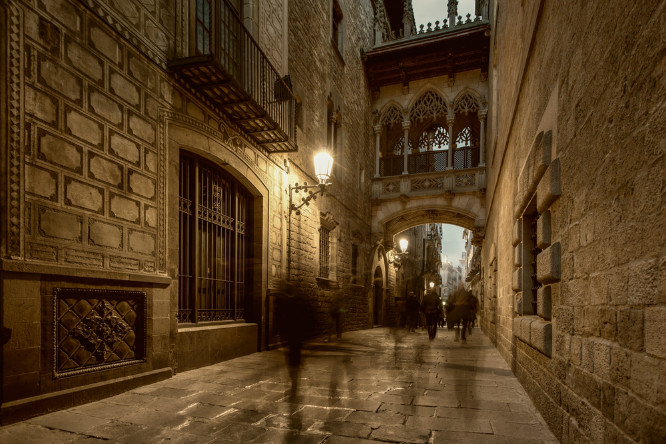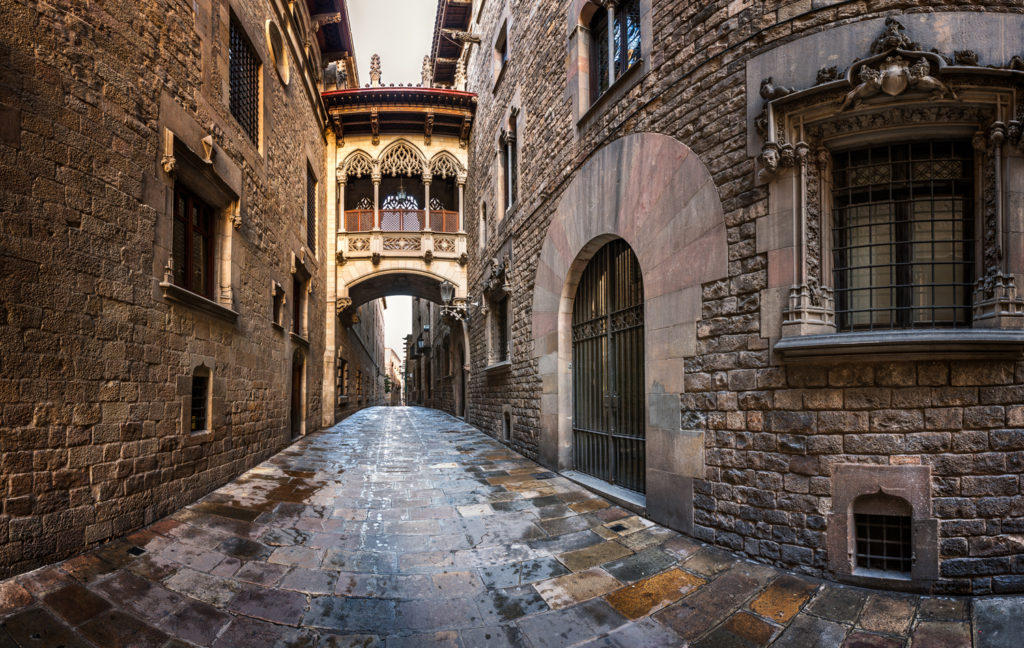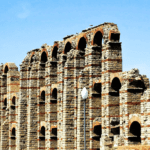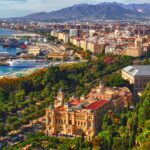
Barrio Gótico
Barrio Gótico (Gothic Quarter) is one of the four districts of the Ciutat Vella (Old Town) area, the old city of Barcelona. It has undergone various changes over time and this creates differences that make it possible to find sculptures of the 20th century close to the 10th century. It is the historical center of the city and in its streets you can see a large commercial activity with many shops and full of companies. You should keep this in mind to avoid visiting the neighborhood during holidays or, at least, not on Sundays. Delving into the history of a city like Barcelona allows you to discover the remains of ancient Barcino, founded by the Romans 2000 years ago and one of the most beautiful cities in Europe during the Middle Ages.
So this is where you can go to the main ancient and the best places to discover the history of Barcelona. Barrio Gótico is located between La Rambla and Via Laietana. These streets are along the sea and you can start your visit from Plaça Catalunya. Walking through any street in the historic center of Barcelona is worth it whether it’s for business, architecture or just for a simple walk.
Cityscape of the Barri Gòtic today
Many narrow and winding streets today shape the city’s urban landscape. La Seu Cathedral is the center of the area. Several sunny squares with historic buildings cluster around the cathedral. The area has been completely renovated several times, most recently for the 1992 tournament. The old structure is preserved with effort and love even today.
Many of the best and most famous museums are located in the central quarter. There are only a few roads used by cars, so you can see Barri Gòtic almost everywhere on foot.
Barri Gòtic is perfect for shopping: countless small shops, shops selling daily necessities and chocolate shops make it easy to spend. The area is worth visiting even at night: many bars and pubs invite you to have a drink or a tapa. You will find many classic Catalan dishes on the restaurant menu.
History of Barri Gotic
The Romans ruled the city for about 500 years – from its foundation in about 133 BC until it was captured by the Visigoths in 410 AD. The Roman settlement was built around the Temple of Augustus north of Plaça Sant Jaume. In the second century, Barcino had 3,500 to 5,000 inhabitants. In the third century the first Christians came to Barcino, the persecution of Christians under Emperor Diocletian began.
In 714, the city was surrendered to the Moors without a fight, so Barcelona escaped destruction. The early Christian cathedral in today’s cathedral grounds has been converted into a mosque. Moorish rule lasted less than 100 years, so there is no known evidence from that time.

In the 12th century, Barcelona became the most important power in the Mediterranean. The old ships of the Drassanes are a visible proof of the era as well as naval power.
From the 19th century, manufacturing (the textile industry) restored wealth and influence. In many places you can see old chimneys. The city walls were demolished from 1854 to 1856. The area around the harbor was completely renovated for the 1992 Summer Olympics.
From the window of Conesa (my favorite local sandwich shop) with my bacon, vegetable and cheese sandwich in hand, I look out over St James Square where the Barcelona bus drivers protest the competition of Uber provided. As they raise their signs and chant Queen’s “We Are Victorious,” I can’t imagine if the political protests in the ancient Roman Forum resembled these modern protests. This center in Barcelona’s Gothic Quarter served as a meeting place for the ancient Roman city of Barcino, and is just one of the many stories about the rich history of Barcelona and Catalonia that unites this cosmopolitan city. of this time in the time of Christ.
In the main street of El Barrio Gotico, you’ll find ancient Romanesque churches tucked away in a dingy street, a dark, dusty and quiet escape from the hustle and bustle of Las Ramblas. You can see the legend of Sant Jordi engraved on the intricate gargoyles that decorate the palace.
You can see San Nicolas, a small hidden church where Antoni Gaudi prayed every day. You can find archives containing letters from Christopher Columbus to Queen Isabella and King Ferdinand as he embarks on his journey to the New World. You can find the famous Fredric Mares Museum, which has more than 3,000 works of sculpture from all periods of human history. Although its name is El Barrio Gotico, this area in the center of Barcelona is not limited to the history and art of the medieval period.
El Barrio Gotico has been the heart of Barcelona from its foundation as a Roman port to its expansion into an international city of over seven million people. Each time, each historical event, each artistic movement, each inhabitant of Barcelona, most roads with cloths, at the prayers sent by the local church. . El Barrio Gotico has the heart and imagination of all who meet it.
What to do in Gotic
Scavenger Hunt in the Gothic Quarter
There are many treasures to discover in the narrow streets of the Gothic Quarter. If you like retro fashion or underground style, visit Carrer Avinyó and the surrounding streets. For art, bric-a-brac and curios, pop into the antique shops along Carrer de la Palla. For traditional tiles, bowls or pitchers, there is a great ceramic shop on Carrer Escudelers.
La Ciutat Museum
Overlooking Plaça del Rei, where Christopher Columbus is said to have made his miraculous return from the New World, the city’s museums are filled with Roman artefacts and centuries-old artifacts.
The exhibition traces the city’s history from the beginnings of Iberian rule to its golden age as a medieval port, including the conquests of the Visigoths and the Moors. In it, you will find the Palau Padellàs, a Gothic palace, which was carried in stone from Carrer de Mercaders to Plaça del Rei in 1931. You will also see Roman excavations outside of Rome.
El Bosc de les Fades
El Bosc de les Fades means “the forest,” and the Sangria grotto near Las Ramblas is famously decorated. The bar is located next to the wax museum and is hidden. The wax museum is housed in a beautiful 19th century neoclassical building. Wax figures offer a mix of culture, history, music and entertainment. In the restaurant, you will find fake trees, empty mirrors, live music, and artificial thunder that are part of the experience.







